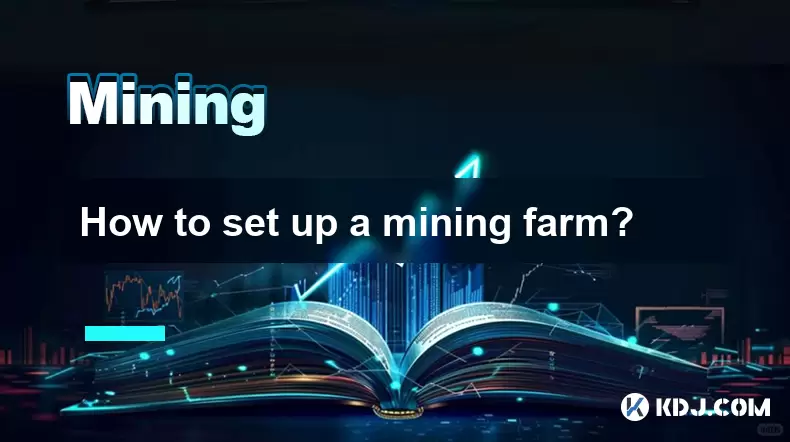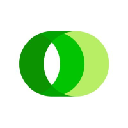-
 bitcoin
bitcoin $120167.907534 USD
1.27% -
 ethereum
ethereum $4468.611945 USD
2.53% -
 xrp
xrp $3.013607 USD
1.80% -
 tether
tether $1.000549 USD
-0.01% -
 bnb
bnb $1092.592149 USD
6.28% -
 solana
solana $231.391244 USD
4.59% -
 usd-coin
usd-coin $0.999699 USD
-0.04% -
 dogecoin
dogecoin $0.259020 USD
4.30% -
 tron
tron $0.342747 USD
0.34% -
 cardano
cardano $0.860977 USD
1.07% -
 hyperliquid
hyperliquid $50.155412 USD
5.34% -
 chainlink
chainlink $22.637678 USD
0.46% -
 ethena-usde
ethena-usde $1.000528 USD
-0.07% -
 avalanche
avalanche $30.613779 USD
-0.07% -
 stellar
stellar $0.403905 USD
0.94%
How to set up a mining farm?
A mining farm uses specialized hardware like ASICs or GPUs to validate blockchain transactions and earn cryptocurrency rewards.
Jul 17, 2025 at 02:21 am

Understanding the Basics of a Mining Farm
Setting up a mining farm begins with understanding what cryptocurrency mining entails. Cryptocurrency mining involves solving complex mathematical problems to validate transactions on the blockchain, and miners are rewarded with newly minted coins for their efforts. A mining farm is essentially a large-scale operation where multiple mining rigs or ASICs (Application-Specific Integrated Circuits) are used simultaneously to increase computational power and mining efficiency.
Before diving into hardware purchases, it's crucial to research which cryptocurrencies are profitable to mine based on current difficulty levels, block rewards, and market prices. Popular choices include Bitcoin (BTC), Ethereum (ETH), and Litecoin (LTC), although each requires different mining equipment and strategies.
Selecting the Right Hardware
The choice of mining hardware significantly impacts your farm’s performance and profitability. ASIC miners are designed specifically for mining algorithms like SHA-256 (used by Bitcoin), while GPU miners offer versatility and can mine various altcoins such as Ethereum. When selecting hardware, consider factors like hash rate, power consumption, cost, and availability.
For instance, Bitmain Antminer S19 Pro is a popular ASIC miner for Bitcoin, offering high hash rates with relatively efficient energy use. On the other hand, NVIDIA RTX 3090 or AMD Radeon RX 6800 XT GPUs are widely used in GPU mining farms due to their excellent hashrate per watt ratio when mining Ethereum or similar coins.
It’s also essential to calculate the break-even point for each piece of hardware. This includes factoring in electricity costs, initial investment, and expected earnings. Many online calculators, such as those found on WhatToMine or CryptoCompare, can help estimate these figures.
Choosing a Suitable Location and Power Supply
A successful mining farm requires a location that offers stable electricity supply, proper ventilation, and sufficient space for all mining rigs. Mining generates a significant amount of heat, so adequate cooling systems like fans or air conditioning units must be installed to prevent overheating and hardware damage.
Power consumption is one of the biggest operational costs in mining. Therefore, securing access to low-cost electricity is vital. Some miners set up operations in countries or regions with cheap hydroelectric or geothermal power, such as Iceland or parts of Canada.
Each mining unit requires a dedicated power supply unit (PSU) or a multi-outlet configuration capable of handling high wattage. It's important to ensure that your electrical wiring and circuit breakers can support the load without tripping or causing safety hazards.
Setting Up the Mining Software
Once the hardware and location are ready, the next step is installing the appropriate mining software. The type of software depends on the cryptocurrency being mined and the hardware used. For example, CGMiner and BFGMiner are commonly used for ASIC mining, while NiceHash and Claymore’s Dual Miner are preferred for GPU-based operations.
Configuring the software involves connecting to a mining pool, which allows miners to combine their computational power and share rewards proportionally. Joining a reputable mining pool increases the chances of earning steady income rather than relying on solo mining, which can be highly unpredictable.
After choosing a mining pool, you will need to input the pool address, port number, username, and password into the mining software. These credentials are usually provided by the pool service upon registration. It’s advisable to test the setup with one rig before deploying the entire farm to ensure everything runs smoothly.
Monitoring and Maintenance of Your Mining Farm
Continuous monitoring is necessary to maintain optimal performance and detect issues early. Tools like Awesome Miner or Minerstat allow remote management of mining rigs, including real-time monitoring of temperatures, fan speeds, and hashrates.
Regular maintenance includes cleaning dust from components, checking for firmware updates, and ensuring that all cables and connections remain secure. Over time, wear and tear can affect mining efficiency, especially if cooling systems aren’t functioning properly.
Additionally, keeping track of earnings through platforms like Blockchair or Etherscan helps verify that payouts from mining pools are accurate and timely. Logging all expenses and income is also critical for tax purposes and long-term financial planning.
Security Considerations for Mining Farms
Mining farms are attractive targets for cyberattacks due to the potential value of both hardware and mined assets. Implementing strong security measures is essential. Start by using firewalls and antivirus software to protect mining machines from malware and unauthorized access.
Two-factor authentication (2FA) should be enabled for all accounts related to mining pools and wallet services. Also, storing mined cryptocurrencies in cold wallets instead of leaving them on exchanges or hot wallets reduces the risk of theft.
Physical security is equally important. Locking mechanisms, surveillance cameras, and restricted access to the mining facility can prevent hardware theft or tampering.
Frequently Asked Questions
Q: Can I start a mining farm at home?Yes, but it requires careful planning regarding space, cooling, and electricity usage. Residential setups may not be ideal for large-scale mining due to noise and heat concerns.
Q: Is cloud mining a better alternative to setting up a physical farm?Cloud mining eliminates the need for hardware and maintenance but comes with risks such as scams and lower profit margins. Physical farms provide more control and potentially higher returns over time.
Q: How many miners should I start with in a farm?Beginners typically start with 1–3 miners to understand the process before scaling up. Starting small allows learning without heavy upfront investment.
Q: Do I need an internet connection for every mining machine?Each miner needs to connect to the network, either via Ethernet or Wi-Fi. A stable and fast internet connection is crucial for uninterrupted mining and communication with the mining pool.
Disclaimer:info@kdj.com
The information provided is not trading advice. kdj.com does not assume any responsibility for any investments made based on the information provided in this article. Cryptocurrencies are highly volatile and it is highly recommended that you invest with caution after thorough research!
If you believe that the content used on this website infringes your copyright, please contact us immediately (info@kdj.com) and we will delete it promptly.
- BlockDAG, DOGE, HYPE Sponsorship: Crypto Trends Shaping 2025
- 2025-10-01 00:25:13
- Deutsche Börse and Circle: A StableCoin Adoption Powerhouse in Europe
- 2025-10-01 00:25:13
- BlockDAG's Presale Buzz: Is It the Crypto to Watch in October 2025?
- 2025-10-01 00:30:13
- Bitcoin, Crypto, and IQ: When Genius Meets Digital Gold?
- 2025-10-01 00:30:13
- Stablecoins, American Innovation, and Wallet Tokens: The Next Frontier
- 2025-10-01 00:35:12
- NBU, Coins, and Crypto in Ukraine: A New Yorker's Take
- 2025-10-01 00:45:14
Related knowledge

The difference between staking and mining
Sep 24,2025 at 05:18am
Understanding Staking in the Cryptocurrency Ecosystem1. Staking involves holding funds in a cryptocurrency wallet to support the operations of a block...

How to participate in testnet mining?
Sep 22,2025 at 09:18am
Understanding Testnet Mining in the Crypto Ecosystem1. Testnet mining is a method used by blockchain developers to simulate real-world conditions on a...

How to dispose of abandoned mining machines?
Sep 19,2025 at 08:19pm
Assessing the Condition of Abandoned Mining Rigs1. Begin by inspecting each mining machine for visible damage, corrosion, or missing components. Machi...

How to identify high-quality mining pools?
Sep 21,2025 at 03:19pm
Reputation and Track Record1. A mining pool’s reputation is built over time through consistent performance and transparency. Pools that have operated ...

Advantages of decentralized mining pools
Sep 20,2025 at 04:36pm
Enhanced Security and Resistance to Censorship1. Decentralized mining pools operate on blockchain-based smart contracts, eliminating the need for a ce...

What is mining machine overclocking?
Sep 21,2025 at 07:19pm
Understanding Mining Machine Overclocking1. Mining machine overclocking refers to the process of increasing the operating frequency of a cryptocurrenc...

The difference between staking and mining
Sep 24,2025 at 05:18am
Understanding Staking in the Cryptocurrency Ecosystem1. Staking involves holding funds in a cryptocurrency wallet to support the operations of a block...

How to participate in testnet mining?
Sep 22,2025 at 09:18am
Understanding Testnet Mining in the Crypto Ecosystem1. Testnet mining is a method used by blockchain developers to simulate real-world conditions on a...

How to dispose of abandoned mining machines?
Sep 19,2025 at 08:19pm
Assessing the Condition of Abandoned Mining Rigs1. Begin by inspecting each mining machine for visible damage, corrosion, or missing components. Machi...

How to identify high-quality mining pools?
Sep 21,2025 at 03:19pm
Reputation and Track Record1. A mining pool’s reputation is built over time through consistent performance and transparency. Pools that have operated ...

Advantages of decentralized mining pools
Sep 20,2025 at 04:36pm
Enhanced Security and Resistance to Censorship1. Decentralized mining pools operate on blockchain-based smart contracts, eliminating the need for a ce...

What is mining machine overclocking?
Sep 21,2025 at 07:19pm
Understanding Mining Machine Overclocking1. Mining machine overclocking refers to the process of increasing the operating frequency of a cryptocurrenc...
See all articles










































































